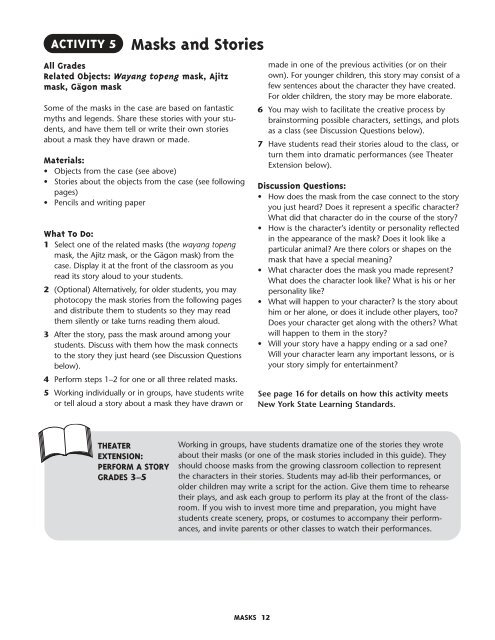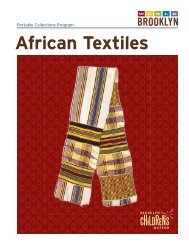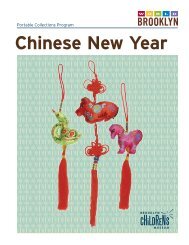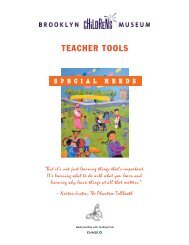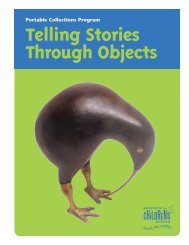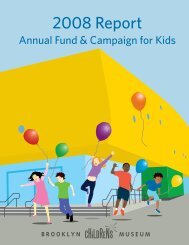What Are Masks For? - Brooklyn Children's Museum
What Are Masks For? - Brooklyn Children's Museum
What Are Masks For? - Brooklyn Children's Museum
You also want an ePaper? Increase the reach of your titles
YUMPU automatically turns print PDFs into web optimized ePapers that Google loves.
ACTIVITY 5<br />
<strong>Masks</strong> and Stories<br />
All Grades<br />
Related Objects: Wayang topeng mask, Ajitz<br />
mask, Gägon mask<br />
Some of the masks in the case are based on fantastic<br />
myths and legends. Share these stories with your students,<br />
and have them tell or write their own stories<br />
about a mask they have drawn or made.<br />
Materials:<br />
• Objects from the case (see above)<br />
• Stories about the objects from the case (see following<br />
pages)<br />
• Pencils and writing paper<br />
<strong>What</strong> To Do:<br />
1 Select one of the related masks (the wayang topeng<br />
mask, the Ajitz mask, or the Gägon mask) from the<br />
case. Display it at the front of the classroom as you<br />
read its story aloud to your students.<br />
2 (Optional) Alternatively, for older students, you may<br />
photocopy the mask stories from the following pages<br />
and distribute them to students so they may read<br />
them silently or take turns reading them aloud.<br />
3 After the story, pass the mask around among your<br />
students. Discuss with them how the mask connects<br />
to the story they just heard (see Discussion Questions<br />
below).<br />
4 Perform steps 1–2 for one or all three related masks.<br />
5 Working individually or in groups, have students write<br />
or tell aloud a story about a mask they have drawn or<br />
made in one of the previous activities (or on their<br />
own). <strong>For</strong> younger children, this story may consist of a<br />
few sentences about the character they have created.<br />
<strong>For</strong> older children, the story may be more elaborate.<br />
6 You may wish to facilitate the creative process by<br />
brainstorming possible characters, settings, and plots<br />
as a class (see Discussion Questions below).<br />
7 Have students read their stories aloud to the class, or<br />
turn them into dramatic performances (see Theater<br />
Extension below).<br />
Discussion Questions:<br />
• How does the mask from the case connect to the story<br />
you just heard? Does it represent a specific character?<br />
<strong>What</strong> did that character do in the course of the story?<br />
• How is the character’s identity or personality reflected<br />
in the appearance of the mask? Does it look like a<br />
particular animal? <strong>Are</strong> there colors or shapes on the<br />
mask that have a special meaning?<br />
• <strong>What</strong> character does the mask you made represent?<br />
<strong>What</strong> does the character look like? <strong>What</strong> is his or her<br />
personality like?<br />
• <strong>What</strong> will happen to your character? Is the story about<br />
him or her alone, or does it include other players, too?<br />
Does your character get along with the others? <strong>What</strong><br />
will happen to them in the story?<br />
• Will your story have a happy ending or a sad one?<br />
Will your character learn any important lessons, or is<br />
your story simply for entertainment?<br />
See page 16 for details on how this activity meets<br />
New York State Learning Standards.<br />
THEATER<br />
EXTENSION:<br />
PERFORM A STORY<br />
GRADES 3–5<br />
Working in groups, have students dramatize one of the stories they wrote<br />
about their masks (or one of the mask stories included in this guide). They<br />
should choose masks from the growing classroom collection to represent<br />
the characters in their stories. Students may ad-lib their performances, or<br />
older children may write a script for the action. Give them time to rehearse<br />
their plays, and ask each group to perform its play at the front of the classroom.<br />
If you wish to invest more time and preparation, you might have<br />
students create scenery, props, or costumes to accompany their performances,<br />
and invite parents or other classes to watch their performances.<br />
MASKS 12


